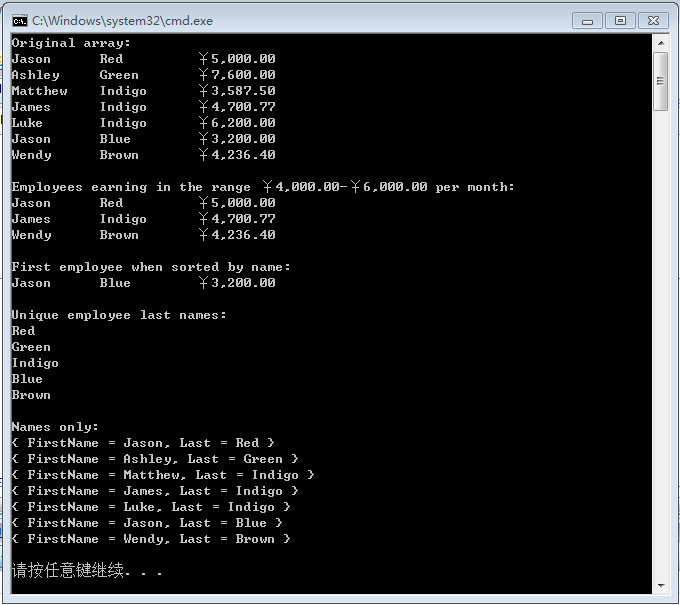一、模块代码
' Fig. 9.4: LINQWithArrayOfObjects.vb
' LINQ to Objects using an array of Employee objects.
Module LINQWithArrayOfObjects
Sub Main()
' initialize array of employees
Dim employees As Employee() = { _
New Employee("Jason", "Red", 5000D), _
New Employee("Ashley", "Green", 7600D), _
New Employee("Matthew", "Indigo", 3587.5D), _
New Employee("James", "Indigo", 4700.77D), _
New Employee("Luke", "Indigo", 6200D), _
New Employee("Jason", "Blue", 3200D), _
New Employee("Wendy", "Brown", 4236.4D)} ' end initializer list
Display(employees, "Original array") ' display all employees
' filter a range of salaries using AndAlso in a LINQ query
Dim between4K6K = _
From e In employees _
Where e.MonthlySalary >= 4000D AndAlso e.MonthlySalary <= 6000D _
Select e
' display employees making between 4000 and 6000 per month
Display(between4K6K, String.Format( _
"Employees earning in the range {0:C}-{1:C} per month", _
4000, 6000))
' order the employees by last name, then first name with LINQ
Dim nameSorted = _
From e In employees _
Order By e.LastName, e.FirstName _
Select e
Console.WriteLine("First employee when sorted by name:") ' header
' attempt to display the first result of the above LINQ query
If nameSorted.Count() = 0 Then
Console.WriteLine("not found" & vbNewLine)
Else
Console.WriteLine(nameSorted.First().ToString() & vbNewLine)
End If
' use LINQ's Distinct clause to select unique last names
Dim lastNames = _
From e In employees _
Select e.LastName _
Distinct
' display unique last names
Display(lastNames, "Unique employee last names")
' use LINQ to select first and last names
Dim names = _
From e In employees _
Select e.FirstName, Last = e.LastName
Display(names, "Names only") ' display full names
End Sub ' Main
' display a sequence of any type, each on a separate line
Sub Display(Of T)(ByVal results As IEnumerable(Of T), ByVal header As String)
Console.WriteLine("{0}:", header) ' display header
' display each element, separated by spaces
For Each element As T In results
Console.WriteLine(element)
Next
Console.WriteLine() ' add end of line
End Sub ' Display
End Module ' LINQWithArrayOfObjects
' **************************************************************************
' * (C) Copyright 1992-2009 by Deitel & Associates, Inc. and *
' * Pearson Education, Inc. All Rights Reserved. *
' * *
' * DISCLAIMER: The authors and publisher of this book have used their *
' * best efforts in preparing the book. These efforts include the *
' * development, research, and testing of the theories and programs *
' * to determine their effectiveness. The authors and publisher make *
' * no warranty of any kind, expressed or implied, with regard to these *
' * programs or to the documentation contained in these books. The authors *
' * and publisher shall not be liable in any event for incidental or *
' * consequential damages in connection with, or arising out of, the *
' * furnishing, performance, or use of these programs. *
' **************************************************************************
二、类代码
' Fig. 9.3: Employee.vb
' Employee class with FirstName, LastName and MonthlySalary properties.
Public Class Employee
Private firstNameValue As String ' first name of employee
Private lastNameValue As String ' last name of employee
Private monthlySalaryValue As Decimal ' monthly salary of employee
' constructor initializes first name, last name and monthly salary
Public Sub New(ByVal first As String, ByVal last As String, ByVal salary As Decimal)
FirstName = first
LastName = last
MonthlySalary = salary
End Sub ' New
' property that gets and sets the employee's first name
Public Property FirstName() As String
Get
Return firstNameValue
End Get
Set(ByVal value As String)
firstNameValue = value
End Set
End Property ' FirstName
' property that gets and sets the employee's last name
Public Property LastName() As String
Get
Return lastNameValue
End Get
Set(ByVal value As String)
lastNameValue = value
End Set
End Property ' LastName
' property that gets and sets the employee's monthly salary
Public Property MonthlySalary() As Decimal
Get
Return monthlySalaryValue
End Get
Set(ByVal value As Decimal)
If value >= 0 Then ' if salary is non-negative(非负)
monthlySalaryValue = value
End If
End Set
End Property ' MonthlySalary
' return a String containing the employee's information
' left justify each field, and give large enough spaces so all the columns line up.
Public Overrides Function ToString() As String
Return String.Format("{0,-10} {1,-10} {2,10:C}", FirstName, LastName, MonthlySalary)
End Function ' ToString
End Class ' Employee
' **************************************************************************
' * (C) Copyright 1992-2009 by Deitel & Associates, Inc. and *
' * Pearson Education, Inc. All Rights Reserved. *
' * *
' * DISCLAIMER: The authors and publisher of this book have used their *
' * best efforts in preparing the book. These efforts include the *
' * development, research, and testing of the theories and programs *
' * to determine their effectiveness. The authors and publisher make *
' * no warranty of any kind, expressed or implied, with regard to these *
' * programs or to the documentation contained in these books. The authors *
' * and publisher shall not be liable in any event for incidental or *
' * consequential damages in connection with, or arising out of, the *
' * furnishing, performance, or use of these programs. *
' **************************************************************************
三、运行结果

来源:Visual Basic 2008 how to program